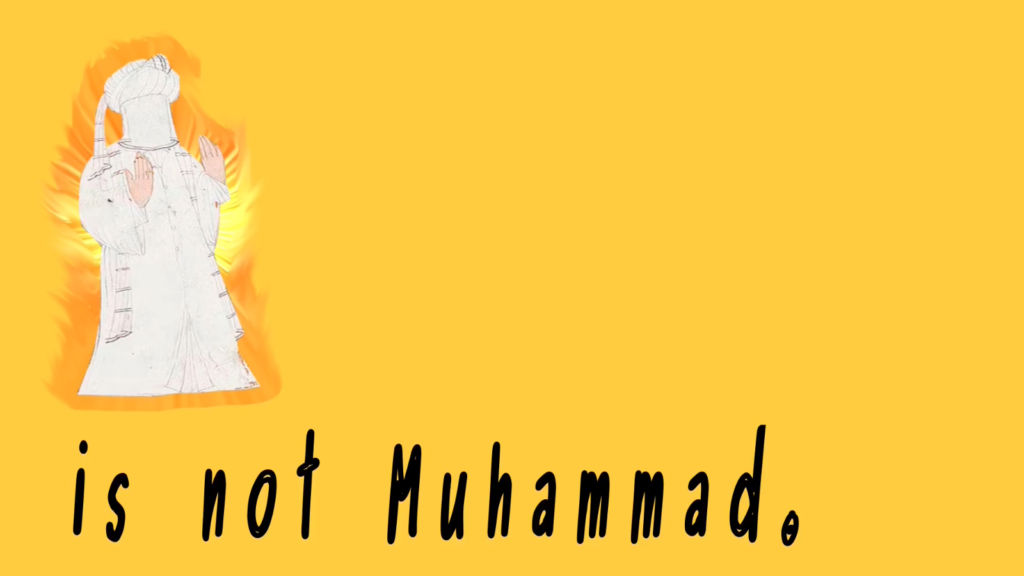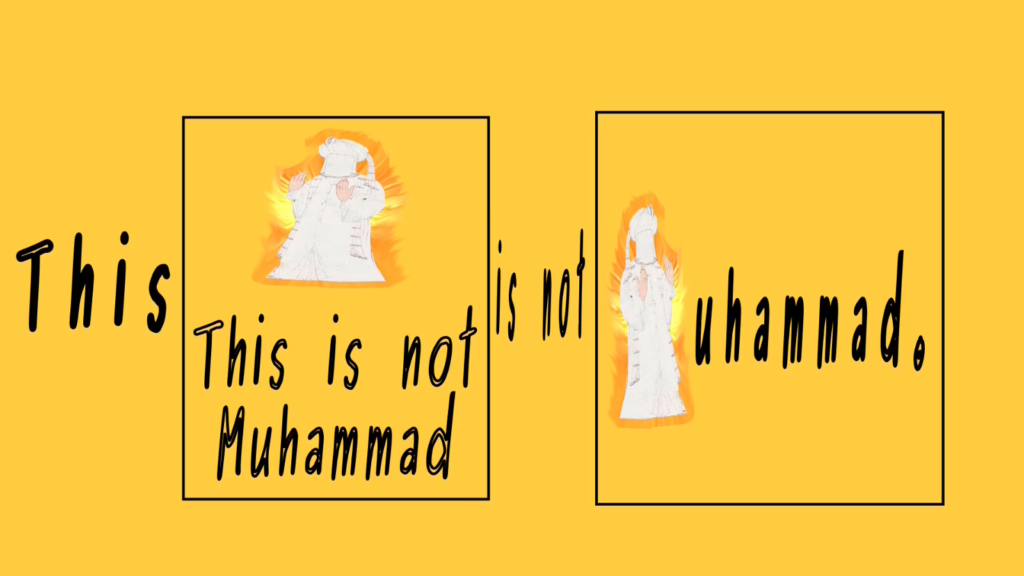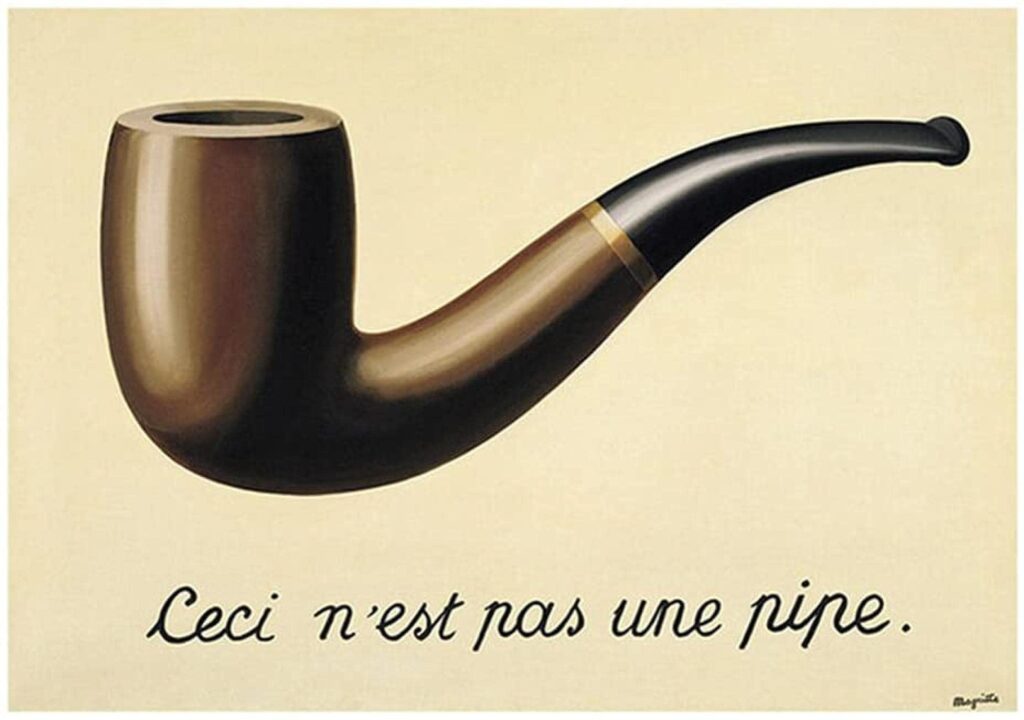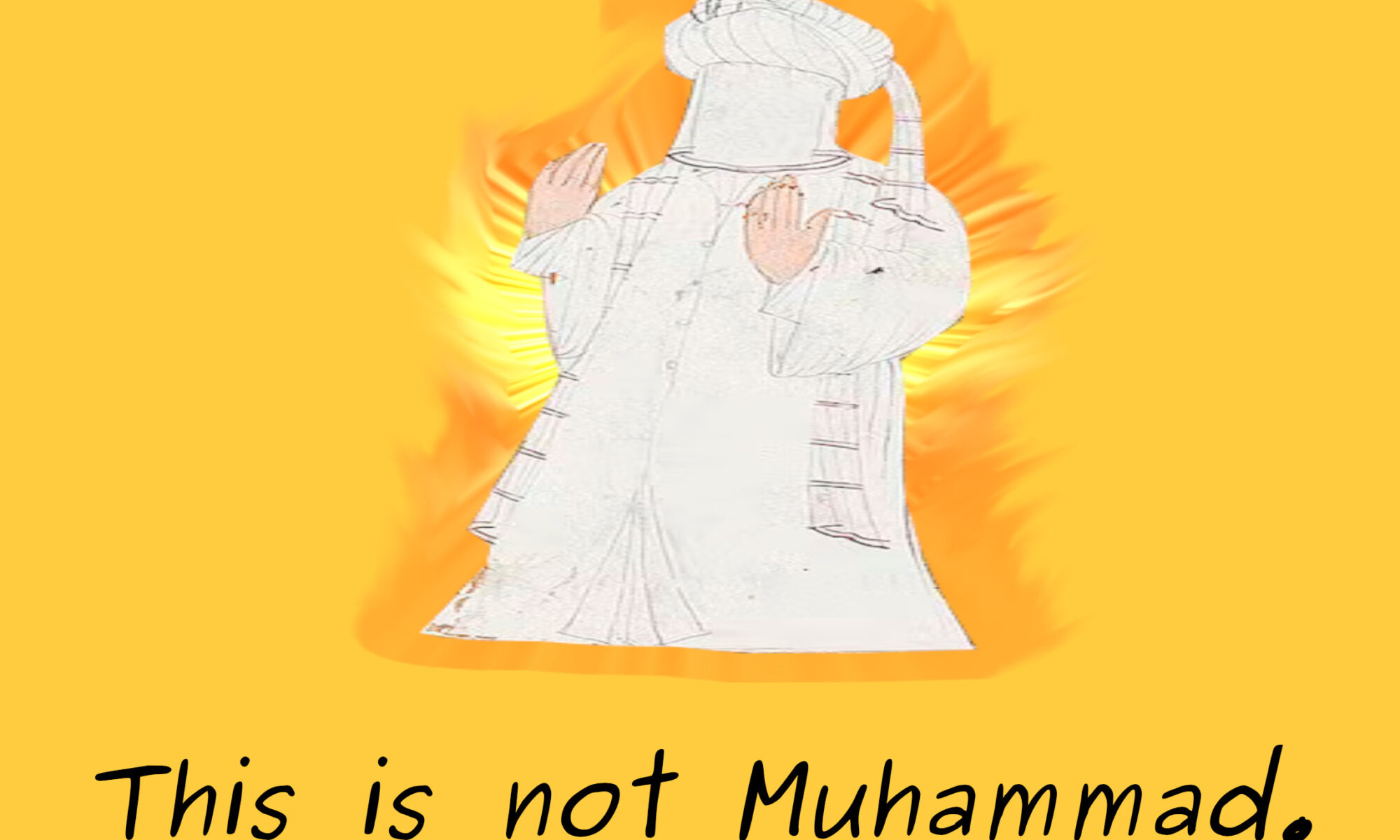01/25/2023
Citations:
Foucault, Michel. This Is Not a Pipe. Translated by James A. Harkness, University of California Press, 2008. Buy here!
As an Amazon Associate, I earn from qualifying purchases.
TRANSCRIPT
This… is absolutely & unequivocally NOT the prophet Muhammad (peace be upon him).
In this picture, we have an image of the Prophet Muhammad, and below it, the words, “This is not Muhammad.” The image is Muhammad, shown with a veiled face and halo, from a painting of him at Mount Hira . It is from a 16th-century Ottoman illustration of the 14th century Siyer-i Nebi, an epic on the prophet Muhammad’s life.
At first sight, it seems absurdly simple-minded. Obviously the image of Muhammad is a mere representation of the actual person, and is not the actual person (peace be upon him). Yet, when we ask “What is this a drawing of?” “Why it’s a heifer, a bee, an ant.” It is the thing it presents itself as.
This picture challenges us in a number of ways, and is constructed with various ambiguities. To paraphrase French Philosopher Michel Foucault, there are two Muhammads here. Or there are two drawings of the same Muhammad? Or Muhammad and the drawing of Muhammad, or two drawings each representing different Muhammads? Or two drawings, one representing Muhammad the other not; or two more drawings of which neither are or represent Muhammad. (16)
But what even is this image of? It is not so simple as a pipe, where we would say, “whatchu talking about, that’s clearly a pipe.” The image is not obvious, but hides what it represents. The face is literally hidden by a white veil. It’s only by reading the declaratory statement written below do we actually know what the image is. It is an image of the Muslim prophet Muhammad (peace be upon him), the founder of Islam. The image, a grouping of pixels drawn by a computer to this background, is itself part of a context of what is not pixelized at all and even what is forbidden to be pixelized. The pixelization of the word Muhammad is allowed. However, for a majority of Muslims, especially Sunni Muslims, any visual pixelization of the prophet Muhammad (peace be upon him) is haram, forbidden (though #notallmuslims). Visual pixelations of living things could be seen as idolatry, worshiping a mere idol instead of the one true God. To worship an imperfect idol, over the perfect God would make God very very angry, and you wouldn’t like God when he’s angry.
The first pillar of Islam, Shahada, or the declaration of faith is the recitation that “There is no God but God, and Muhammad is His Prophet.” Islam is monotheistic. God is unified with Himself, and God is the singular source of all existence; the uncaused first cause. This is the first thing said to newborns, it is said during every prayer, and is the last thing whispered into a person’s ear before they die. Worshiping to an image, even an image which is a representation to the one true God, is blasphemy cause it is worship of something which is manifestly not God.
Yet, this picture seems to agree with the common prohibition on pixelization of the prophet. At the same time the statement, itself a drawing of pixels, describes what the image is of, it also tells us it is not what the image is. The sentence refers precisely to the disproportionate, floating, imperfect Muhammad. It is a fantasy of Muhammad. A mere pipe dream of Muhammad.
Because there are so few images of the prophet Muhammad in circulation, In order for the image to even make sense, in order for it be meaningfully symbolic, the text has to invade the picture, even taking the place of the symbolic. Because of the prohibitions and even the lack of features provided by the image, the image forces you to look elsewhere to find it’s answers, the text, but once you’ve reached the text, you become aware of the prohibitions on such an image. The drawing of the word pushes you away from itself, perhaps even away from the picture altogether; but, at the same time, the pixels of the word seduces towards the pixels of the image. As Foucault says:
The text “has returned to its natural site—below the image, where it serves to support it, name it, explain it, decompose it, insert it in the series of texts and in the pages of the book.”
Foucault, Michel. This Is Not a Pipe. Translated by James A. Harkness, University of California Press, 2008. (22) Buy here!
This pushing us away makes the other almost disappear when looking elsewhere.
“The thing that is both seen & read is hushed in the vision, hidden in the reading.”
Foucault, Michel. This Is Not a Pipe. Translated by James A. Harkness, University of California Press, 2008. (25) Buy here!
They each have their own place in the painting but maintain a type of evasiveness. As soon as I begin to read, “This is not Muhammad.” the shape disappears. If I then look at the shape of the image, the pixelized text recedes. It seems the only way we can get a grasp of both is to superimpose them on each other.
Now, if this were a picture of something obvious like a pipe, the pipe might say, “You see me so clearly that it would be ridiculous for me to arrange myself so as to write: This is a pipe. To be sure,” the pipe says, “words would draw me less adequately than I represent myself.” But, this is not the case with the featureless image of the prophet Muhammad. The pixelized word does draw more than the image, at least initially. Attached to the word, Muhammad, is a whole series of definite descriptions: Born on or abouts 570 C.E., born in the Holy City of Mecca, his full name is Abu al-Qasim Muhammad ibn Abdullah ibn Abd al-Muttalib ibn Hashim, he was visited by the Angel Jibril in 610 C.E. and told to recite versus which would become the Holy Quran, husband of Khadija bint Khuwaylid, Sawda bint Zamʿah, Aisha bint Abu Bakr, Hafsa bint Umar and Zaynab bint Khuzayma, also Umm Salama, Umm Habiba, Rayhana bint Zayd, Zaynab bint Jahsh, Juwayriyya bint al-Harith, Safiyya bint Huyayy Ibn Akhtab, Maymuna binti al-Harith, he died on Monday, June 8th, 632 C.E. and so on and so forth. It is only by means of these definite descriptions does the pixelized word Muhammad gain any meaning. The word itself excavates the image of Muhammad. But, the image of Muhammed says, “You must look away from me to know me.”
At the same time the text, so nonchalantly pixelized below the image, would be forced to say, “Take me for what I am—discontinuous lines, haphazardly formed into discrete letters, arranged and shaped so as to facilitate reading, assure recognition. I am no more than the words you are reading. The real treasure is in what is normally unsaid & undrawn, the image above.”
Between these two positions, lies a subtle and unstable dependence on each other, a dependence which finds its axis in the word “This.” There’s a whole series of interconnections between image & the text that hinge on “This.”
For instance, “this” (this drawing, whose form likely reveals little and pushes us away from it) “is not” (is not substantially bound to…., is not constituted by…., Does not cover the same material as….) “Muhammad” (this word from your language, made up of pronounceable sounds that translate the letters you are reading). Therefore, “This is not Muhammad” can be read thusly:

Another interpretation could be: “this” (the statement arranging itself beneath your eyes in a line of discontinuous elements, of which this is both the signifier and the first word) “is not” (could neither equal nor substitute for….., could not adequately represent…..) “Mohammed” (one of the objects whose possible rendering can be seen above the text—interchangeable, anonymous, inaccessible to any name). The we must read:

For a third instance or function of this statement: “this” (this ensemble contstituted by a written Muhammad and a drawn text) “is not” (is incompatible with) “Muhammad (that mixed element springing at once from discourse and the image, whose ambiguous being the verbal & visual play the pictures wants to evoke). Then, our only option is to view it thusly:

It is between these two highly contentious drawings, in the empty, calm sand of the picture, that all the relations of designation, nomination, description, & classification betray the evasiveness of the drawings.
By the pictures own admission, no where is the prophet Muhammad. Negations seem to multiply themselves ad infinitum. “This is not Muhammad, but a drawing of Muhammad. This is not Muhammad but a sentence saying that this is not Muhammad. This sentence “this is not Muhammad” is not the prophet Muhammad (peace be upon him). In the sentence “this is not Muhammad” this is not Muhammad: the picture, the written sentence, the image drawn—all of this is not the prophet Muhammad (peace be upon him).

In relation to a similar picture called This Is Not a Pipe, Foucault says the following:
“What misleads us is the inevitability of connecting the text to the drawing (as the demonstrative pronoun, the meaning of the word pipe, and the likeness of the image all invite us to do here)–and the impossibility of defining a perspective that would let us say that the assertion is true, false, or contradictory.”
Foucault, Michel. This Is Not a Pipe. Translated by James A. Harkness, University of California Press, 2008. (20) Buy here!
The painter of This Is Not a Pipe was Rene Margritte who often included texts in his paintings. On the subject, he said:
“Between words and objects one can create new relations and specify characteristics of language and objects generally ignored in everyday life… Sometimes the name of the object takes the place of an image. A word can take the place of an object in reality. An image can take the place of a word in a proposition…. In a painting, words are of the same cloth as images. Rather one sees images & words differently in a painting.”
Rene Margritte
